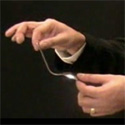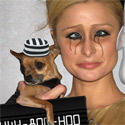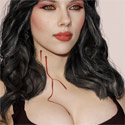Much of my artwork you see at DC may involve illusion, but is not considered magic, since their creative process is apparent in most cases, ie. digital manipulation, obvious optical devices, etc. However, their relation to magic is closer than you may think.
When creating realistic visual art depicting the impossible, the aim is similar to that of magic, only differing in its delivery and presentation.
Magic is an art that requires the same research, dedication and discipline as any other. When performed with the intent to entertain, performance magic becomes an art of illusion, tying in scientific principles and psychology with artistic presentation and choreography. The secrets behind performance magic have been used for many purposes other than to entertain. Such instances include people who claim to have psychic powers for monetary gain, using the art as a tool for deception. Because of this, many have grown to be skeptical of the art, even though the artist, to which they are directing their skepticism, may not have even claimed special powers.
Why do so many viewers of magic, even the highly educated, have the need to proclaim redundancies such as the effect being a trick, or not real? This illustrates that the skeptic may be threatened by the illusion, perhaps feeling as if their intelligence is being questioned. Performance magic is designed to convey a sense of the impossible, with the actual process camouflaged. Great illusions do not discriminate. This is true for both simple optical illusions, as well as performance magic. Illusions rely on the standards of human perception and usually do not benefit from a person’s intelligence.
I don’t claim to have any psychic ability or special powers. I fully advocate the support of magic as an art, nothing more. Then why do people continue to yell things like, ‘It’s a trick!’? Before the performance, I just explained that the illusions presented are not real.
I believe that this skepticism is hindering this fine art, as it sways audience attention away from the wonders of performance magic and the presentation of illusion as an artform. By viewers proclaiming deception, the purpose of the performer is perceptively skewed into a deceptive display. When viewing a movie with realistic special effects, the audience is usually aware of the fact that it is only an effect. Whether the creative process is obviously a spatial illusion, camera trickery , CG, or so realistic that the viewer cannot distinguish between stop motion, CG, or live action, they know it is not real. Why then, don’t they yell out such things as they do when viewing illusionists?
If the art of magic is to continue, performers must make it clear that they are entertainers and nothing more. When experiencing magic, viewers should understand that these illusions are not purely intended to deceive, but are orchestrated tools to convey a story in an impossible manner for entertainment and wonder.
Distinguishing illusion from the supernatural is key, not only for people to appreciate the art of magic, but also for everyone who wishes to see every illusive scenario delivered from news, mass media, religion and even scientific observation for what truly drives the effect or claim. Stars being viewed in the sky are illusions, actually displaying how they appeared eons ago – news stories may be skewed for political intentions – and that ‘volunteer’ from the audience that the magician cuts in half may be his cousin Sally. By distinguishing performance magic from deception and illusion from trickery, we can appreciate creative displays while directing our critical reasoning toward the illusions which hinder our progression.
This doesn’t rule out the existence of the unexplained. In fact, the supernatural is what drives humanity forward, gives science purpose and technology a place in which to be applied.
Real magic takes many forms. Science, technology and even the unexplained and paranormal are sources for everyday awe. They often play a major role in performance magic and illusion, and while seemingly impossible in their own right, they too have their true processes hidden within nature’s abundant wonders.

 When creating realistic visual art depicting the impossible, the aim is similar to that of magic, only differing in its delivery and presentation.
When creating realistic visual art depicting the impossible, the aim is similar to that of magic, only differing in its delivery and presentation.

I’m not a magician but this is an eye opening and inspiring little speech.
ITS A FIXED SPOON DUHHH
I totally concur with #1 that this is a brilliantly well written, extremely informative and well argued piece. I do hope its author goes onto things better than posting articles to a typo ridden interweb as they are clearly a cut above the average human. So that’s a WOO YAY from me then!
“ITS A FIXED SPOON DUHHH”
There’s always one person who’s got to shoot it down. My mother-in-law is much like this, contradictory for contradiction’s sake alone.
Dear DJ,
Keep your purposely charm-killing comments to yourself, and let the rest of us revel in the magic of prestidigitation, hm?